The Complete Guide To Gray Hat SEO – 2025

When talking about how to use SEO, people can be very creative on how to rank better in search engines.
Sometimes the boundaries between white hat SEO, black or gray can be confusing.
In this article, I wrote about few gray hat SEO techniques that will surely grab your attention.
So. keep reading to find out what they are and how to use them.
What is gray hat SEO?
In the world of SEO we can find the good the bad and the ugly guys, so to speak.
White hat SEO is the good guy.
These are legitimate SEO action as right use of meta tags , keyword research, writing optimized content, speed improvements, site architecture, white hat link building etc.
Black hat SEO is the bad guy.
Normally black SEO action would be against search engines guidelines trying to manipulate and improve ranking for search engines
(in short SE).
These can be things as buying links, cloaking, faking signals and other manipulations.
Gray hat SEO is the ugly guy.
Gray refers to methods that are not totally disapproved to use by SE, but still not considered white.
This is because the guidelines in search engines are not clear enough or lack in some way.
Examples are: Buying expired domains, tweaking social media and much more as we’ll see.
Now, for every method that someone calls gray, there will be someone else calling it black or even white (and vise versa).
There is a big dispute in the SEO community for answering what is gray.
Some can see cloaking and buy links as gray while others consider them totally black.
I guess this will be the same case for this post.
It can be that for some methods I’m considering gray, others will call black.
Coming to a conclusion can only be if reading through the SE guidelines,
Assuming they have supplied detailed information on what to do in such cases.
Gray hat SEO advantages and dilemma
The Big advantage of using gray hat SEO is been able to rank fast and more easily than going white.
For some methods, you can get a power that I wonder if you can get the same effect if only using white hat techniques.
I wouldn’t throw the idea of using gray, as there are some relatively safe methods with great results.
Automation is a good example of that as I’ll show later.
The problem with gray hat techniques is that they can turn into black once the SE spotted them used.
In some cases they can pass under the SE radar without been noticed, but once heavily used SE will spot them and can disapprove these gray methods totally.
For example, reading Google Webmaster Guidelines all of these techniques should be avoided:
• Automatically generated content
Any content has been generated programmatically like- Text translation, RSS scrappings, Stitching or combining content
• Participating in link schemes
Buying or selling links, Excessive link exchanges, automated programs to create links
• Creating pages with little or no original content
• Cloaking
Showing different content to users and search engine spiders
• Sneaky redirects
Sending a visitor to a different URL location than the one they requested
• Hidden text or links
• Doorway pages
Sites or pages created deliberately for ranking highly for specific search queries
• Scraped content
Using others website content and publishing it as yours
• Participating in affiliate programs without adding sufficient value
• Loading pages with irrelevant keywords
• Creating pages with malicious behavior: phishing, installing viruses, trojans, etc,
• Abusing rich snippets markup
Showing misleading or false rich snippet information to users
• Sending automated queries to Google
Generating queries to Google for the purpose of ranking higher.
Still, some people find ways to make part of these rules more flexible and to call them gray seo.
Gray methods do carry some risk for using them but can give great benefits.
Gray vs Grey
In this post I’ll alternate the use of both terms, it’s all a matter of location 🙂
Gray Hat SEO Techniques
Buying expired domains
The first gray hat SEO technique that I’ll present is really powerful one but should be done right.
Usually, when buying expired domain there are several options for what you can do with it.
A) Make 301 redirect
The 301 status code says that a page has permanently moved to a new location.
It guides the search engine to redirect users to a new page location.
Also, It passes between 90-99% of link juice to the redirected page.
For more FAQ, read Moz redirection
This is the “classical” way that most people like to use, but also one of the riskier ones if the site has penalties.
B) Keep the domain and get links to your pages
If it’s trusted domain, you can set links to your pages while keeping the domain for other purposes.
In this option, you exploit an only small portion of the domain power, but it can be safer.
C) Set a landing page on that site, redirecting visitors to your site.
If the domain is from the same business you are, you can ask users to visit your site instead.
This is also a more polite way to inform users that the old service is no longer available and invite them in.
It is safer, but you need enough traffic to utilize this one.
It’s better to clarify few things before you decide to buy a domain.
1) Is it relevant to you
The first and most important question would be relevancy.
Look for a domain that is from the same industry/niche your site is.
You don’t want to buy cosmetics domain if your industry is technology.
Google gives significant attention to this point, and the weight of the links as well your site trust are effected from your inbound links.
2) Check that the domain has no penalty
First, type the full domain URL in Google Search and see you get it as a result.
You can also use a tool like Google Sandbox and Penalty Checker Tool
For knowing if the domain is Deindexed (completely removed from Google), Penalized or Sandboxed.
3) Wayback machine
In archive.org you can view how the old site was.
It takes snapshots of domains at different times and saves them.
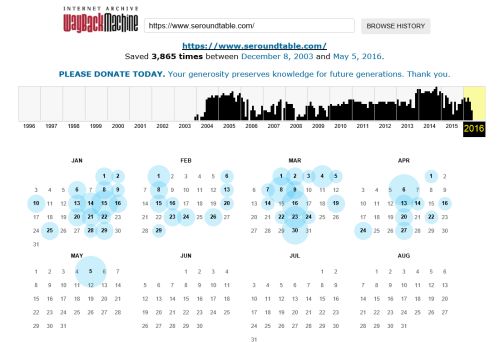
Load the last one and go over the domain to make sure it’s good and not looks spammy.
4) Check the domain spam level
Use a tool like OSE (open site explorer) and look for 0-2 spam score.
Also look at the spam score of the inbound links.
You don’t want to see too many pages with spam score over 5.
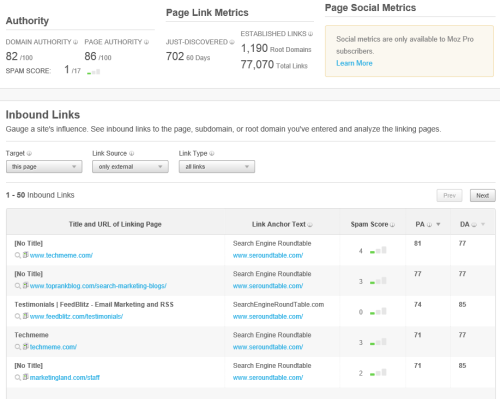
5) Link audit and Anchor profile of the domain
For making a link audit I use a tool as ahref, OSE or a similar one.
Export all link into a CSV for further analysis.
We want to detect unnaturally, paid links and spammy ones.
I won’t go through the whole process but will highlight a few essential points.
A) See that the anchor terms are not over optimized.
Example, for Moz.com you can see the 3 top anchors are moz, seo, seomoz.
Which is good, but the idea would be moz.com is included in the first ones (now it’s at place 10).
If talking about such a strong website, this is not a problem, but for yours- look for natural anchors and brand names
to be the first ones and the most anchor terms.
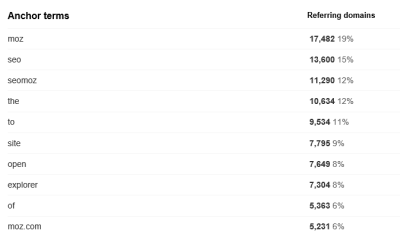
B) As I wrote Brand links should be your biggest portion
Variations can be: DomainName, http://DomainName, DomainName.com, www.DomainName.com, etc.
C) Paid links may be spotted if coming from home pages, not related industries website that links to, side links that link to many unrelated sites.
6) Check the domain traffic
Ahref provides the Organic traffic for domain or you can look at semrush.
If you have the domain, go to archive.org you and upload the old homepage, install Google Analytics and track the traffic.
If it has too low traffic for you, skip the idea.
Social Media Accounts
You should know the importance of using social media to promote your business.
Having multi social accounts is a great way to generate safe signals for your site.
What you need is to create a few figures (not too many) add bio and picture and start promoting these accounts.
Let’s say you have a real business with one twitter account; you can create two more dummy accounts and give your business likes and retweets from there.
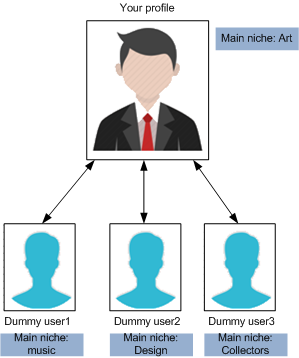
For these dummy accounts, you still need to do some work and to maintain them.
This includes expanding your network, creating connecting with others and publishing materials.
It can also be an overlapping network of people but prefer to create some diversity among them.
For example, if your main profile network is art people, the dummy accounts should be music or design with a smaller portion of art people.
This is good because it expands the boundaries of your original reach.
To manage these accounts from one place you can use a central social software as buffer and HootSuite.
It does require more efforts to make engagements and publish, but it’s a nice social gray hat technique in your arsenal.
As long as you do it yourself, it can be seen as gray.
Multi Tier link building
While this may consider a black hat, still if you’re not pointing too many links to your money site and doing high quality tier 1 layer,
It can be seen as gray. it used to be even white seo a few years ago.
A typical 3 tier pyramid can look something like this:
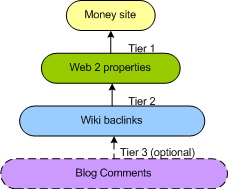
Tier One Backlinks
Tier one are links that point directly to your website (money site).
You want to make these links as quality as possible coming from authoritative sites.
Many of these sites are web 2 websites that allow users to communicate with each other and not only to view content.
Some of the most authority web 2 sites are WordPress, Blogger, Tumblr, Weebly, Webnode, LiveJournal, etc…
Best is to select relevant sites as possible and make sure they are authoritative with nice traffic.
When settings links in this tier, make most of the anchor text unoptimized and small percentage with exact match anchor.
This will help to protect your site from google updates like Penguin.
The number of properties you build from tier-1 is relatively small, 5-25 is enough.
Making high quality pages for this tier is a very important point.
Most people write a single page with less than 500 words for their first tier.
You want to be different, so don’t do the same.
You should have more than one page, add images and write a content of above 500 words.
If possible add terms of service, privacy and contact pages.
These things do take time and effort, but it will make your tier1 pages super strong like a mini niche website that can stand google changes.
Thus making it more easy and safe to build links to that tier.
Tier Two Backlinks
These are links pointing to your tier one links.
The idea, of course, is to strengthen your tier1 links by passing them more link juice.
The options here are endless on how to create them and what to select.
Few ideas: wiki backlinks, video sites, article submission, social bookmarking, more web 2.0 sites, comments, directories, etc.
You can stop the tiered link building here or add more tiers if you like.
The important thing to note is many people are using tier 2 sites coming from social bookmarking, directories and article submission, therefore they are highly spammy these days.
I would focus on web 2.0 sites, video and wiki as my second tier because they are safer to use.
The number of links you build also matter.
It is easy to blast links in tier 2, but I prefer getting fewer links which are good ones instead of taking them from anywhere.
Why? Because relevancy does matter to Google.
If you’re getting links from anyone, how you think Google will categorize your site?
I want to keep my site as trusted as possible, so 10-20 links for each of my first tier links are enough.
Adding More Tiers
The principle is the same, each tier links to the one above it.
To the deeper tiers, you can add more to the link profile, like blog comments, microblogs and forums.
The lower the tier, you’ll probably need to create more links to it.
If adding more layer, increase the number of links to the tier above, like x10 more to each link.
Making frequent changes to your site
Changing the code, text, fonts even slightly, cause the search engines to think you updated the site content.
Doing that without really adding new content can get you some caffeine earned.
The Google Caffeine update gives more score to fresh and recently updated content.

The rate, amount of change and even location have a big influence on this score.
For example, is the change occurs daily, weekly, monthly or more?
Is it small or big change, one paragraph or all document?
Where the change occurred? In the main body text, navigation bar, etc…
I see a surge in traffic almost every time I update my site or add new content, so I can say it works.
Google Map Citations for Local SEO
What is Citation?
A citation is a mention, even without the link that refers to your business name, address and phone number (NAP).
Map Citation is a reference from Google Maps which is created when users save your business location to their maps.
Why is it important?
Google gives Citation high weight when evaluating the authority of a website.
It’s one of the more important keys in Google algorithm as it gives confirmation to what Google knows about your site.
Even if it’s not a link, it is still a measure of your online presence.
This can also improve site local search engine rankings very fast.
Many people know about Citations coming from directories, but there are few more ways to create quality Citations.
Press release, blog comments, articles, Wikipedia are few of them.
How to do Google Map Citations

The technique involves creating several profiles around 10 to 20 around your location and saving your business location to each profile maps.
Consider also making this from different local IP’s address belongs to the same area.
Eventually, this will create a net around the map that leads to your business.
The benefits of such Citation are :
• Having NAP coming from Go.ogle Maps
• Increase the Buzz in Local Area
• Increase of local social signals
• Coverage of your local business radius
Faking Reviews
Reviews are a great way to improve your co-citation.
Co-citation is when a website or brand is mentioned by two or more different sources without links.
It is another way of making citation without using all the NAP data.

I highly recommended that you add your business to some top review sites like- Yelp, Google My Business and Yahoo! Local Listings
And don’t forget to add reviews to them!
19 Online Review Sites for Collecting Business & Product Reviews
Most people that do local citation are doing a set and forget listing.
They don’t look into it anymore after setting, this can be a big mistake.
One way to keep your citation alive and to strength them is to do reviews.
The reviews add credibility and can improve one’s position in the SERP results.
A site that gets many positive reviews will only gain from this.
Both people and search engines like good reviews because it helps them to judge the business better.
The gray side here is to buy or ask from others to give you a good review.
It’s easy to do and can help your business if adding some on few good review sites.
Spin Content

When you spin, you take someone else content, make changes to it an post it as yours.
The tactic is widely used for link building with article posting.
The quality of the spin is also important and there are tools today that can make unique spin that will pass Copyscape and will
Not be considered as plagiarism.
While many free Article Rewriter and Spinner are available, I suggest using quality ones as the best spinner which costs only 37$ per year.
As it comes from software, always check your spun content – see if it’s logical and fits what you need.
Wikipedia Page

Because of the high-value Wikipedia has, many would like to get a link from this authoritative domain.
The link is no-follow but still can leave a good impression on Google.
It can boost your efforts to be included in Google Knowledge Graph.
These days it became even harder getting links from Wikipedia because people are spamming all over.
After all, Wikipedia main purpose is to be encyclopedic and not a tool for marketing.
Wikipedia will consider citing your website only if it comes from a reliable source.
Most sites are not complying with this standard, therefore we need to go gray.
One way to get a link is to donate media (image, infographic, etc) and to provide a link to the source where the image
was obtained. This is not good as a contextual link, but still easy to do and get.
The second way is to create a new Wikipedia page on a topic related to your website while adding your site link.
This is not as easy as it seems and may be hard to implement.
The big problem is the new topic you create should be worth and with some public interest.
It should be notable.
I lately tried to make a simple page with accurate data on me, but when it came to the editor he deleted the page from the reason
I’m not much of a public figure.
So, it can be hard, but there are ways to pass this:
• Select a good and notable topic
• Don’t make it too complex, keep it simple and relevant
• Try to add others good links to the page and not only yours
• Don’t make it look too promotional
• Follow the style and formatting guidelines
If you don’t like to do it yourself, there are some guys who specialize in creating such pages that you can find on the web.
Influencer Marketing

Influencer Marketing is when you use Influencer to promote your business.
It is considered a white hat, but we’ll talk about the gray one.
In that sense, Influencers are people that can reach others much more easily than you.
And I’m not talking about big Influencer in their niche that will most likely reject these methods.
Advertising
Paying for advertising your site on some Influencer site can be a good way to drive more traffic to your site.
If this includes a no-follow link, it will even consider as white hat SEO.
Social promoting
Paid social promoting is a fantastic way to push your content.
Someone with dozens of followers who has reached to many people is like a jump board.
To make it work, pick someone that has some relation to your industry and what you do.
Pay to get interview
Some Influencers are suggesting to give you interview on their sites.
They’ll post kind of Q&A with you and will help you to promote your product.
Another kind is guest posting on their blog while leaving your bio mark there.
Keyword Stuffing
It’s a fact that lengthy content ranks better.
How to use this to gain more organic traffic?
Instead of writing researched articles, you put a lot of content with your target keywords on your post pages.
If it’s spun text, you’ll place it after the main page content.
Users will not surely understand what it is, but there is a bigger change you’ll get more traffic to this pages.
If this is a product page, you can add some label before it saying users to ignore it, like testing.
This is not a very nice way, but it can affect the SERP results for your benefit.
Another related technique is doorway pages. These are pages that optimized to rank high in search engines for
particular keywords (usually one or two).
They are designed to catch visitors and send them to a different page.
WP Robot is a WordPress blog on autopilot plugin.
It offers many options to automate post creations, content curation, RSS feeds, videos, photos, etc.
It enables creating campaigns while selecting target keywords, sources and posts times.
I know about few SEO guys that use this for their clients to expand content and to make frequent changes.
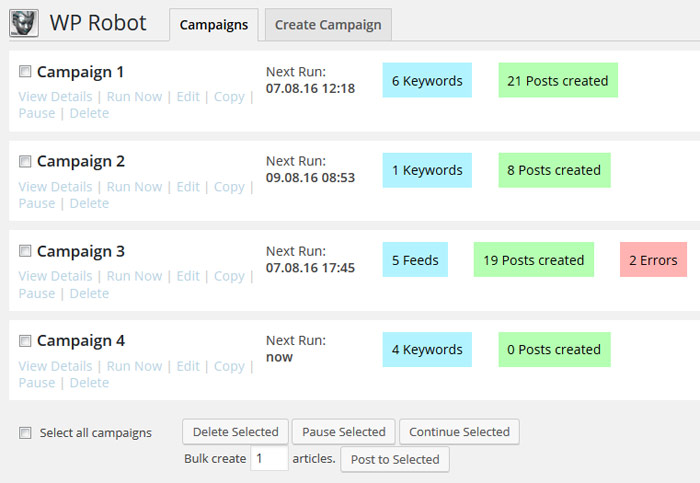
CTR Manipulation
In the post on Google secrets I wrote about Rand Fishkin experiment to manipulate the SERP results.
In short, he used Pogo sticking effect to click on the search results and go back and then to click on result number 4 and stay on the page.
This caused Google to think that the first result is less relevant while the fourth result is more useful to users.
Eventually, the effect was promoting result number 4 to the top of the SERP results for at least few hours.
Is it gray or black SEO method? it depends, because of the timely effect I categorized it as gray SEO.
It is not very hard to that for your search results.
You need to click on your competitor’s results in the SERP and then to go back while clicking on your page and staying there for a while.
Keep in mind to use different IP address and also at different times.
Writing such automotive tool is possible, but I wonder if it’s worth the money you’ll spend.
Instead of SEO automation, you can ask others to do that for you.
There are some social networks where you can give tasks to others and pay with social points.
Gray that is black SEO
Here are several other methods that I’m not considering gray while others do, therefore the focus will be short.

Cloaking
When users are served with a different page than the one indexed by the search engine.
It’s done for the purpose of ranking higher, but mislead both users and SE.
Duplicate content
This is a known issue like article spinning and copying others content.
Plagiarism is causing SE big problems in trying to understand who is the original writer and how to credit in such cases.
It also not beneficial for readers as well to get the same content copied from somewhere else.
If you spin, make sure you pass the text through some content validation as Copyscape or DupliChecker.
Negative SEO
When you use brute methods to lower your competitor ranking so you can be above him in the SERP.
Buying links
Paying someone to link back to your site, which is against Google’s guidelines.
As in every field, things are not seen the same to every one.
It’s no different when it comes to SEO, so people take a different approach on this.
I Hope you enjoyed this post.
What gray hat SEO Techniques you know or use?
Let me know right below.
Recent Posts
17 thoughts on “The Complete Guide To Gray Hat SEO – 2025”
Comments are closed.


Hi James,
It was a super fine article, till date i heard of only black and white hat seo tecniques, this is the first time i’m looking at something called gray hat seo, this is really cool and the techniques mentioned above really worth implementing, thank you for sharing the post.
Hey James,
Agree with AKSHAYKATTAM. First time I am also read something called gray hat SEO.
Nice informations and thanks for sharing some awesome tips.
Cheers
I’m a very hard little white hat seo content, but the first time there is very little traffic so less of backlinks, so I would sneak away the night several times
is blog commenting comes under white hat seo ? i.e if we genuinely post comments on different blogs and receive a backlink ? please do let me know on this.
I personally think “greyhat” is not very useful as a term.
A specific tactic – so specific that, say, “good guest posting” and “spammy guest posting” are different specific tactics here – either works, or it doesn’t.
Some of them may work short term but may likely seem a little off and one may wager that they won’t be effective down the road. So that’s a tactic that works, but not as well as others.
Google’s guidelines have nothing to do with it. To be honest, I think “blackhat” should only refer to techniques that are literally illegal by actual laws, such as hacking someone’s site to inject links. If “blackhat” means “things that Google says aren’t best practices,” with how diluted and convoluted Google’s messaging has gotten, then I’d say just existing in the SEO industry makes us all blackhats since we’re all trying to “influence rank”.
Really it is an informative article. This kind of information is very much needed for my tips. I have personally benefited from it was enough.Thank you for the important article.
I’ve tried few grey hat techniques found some good results too but I mainly focus only on white hat SEO which will be more long term benefited. Sometimes any Google algorithm changes it can hurt our website due to grey hat techniques i would suggest every one to move on with white hat for short term you can try Grey hat.
Thank you so much for this article. I’ve got so many ideas running through my head now – can’t wait to start putting these tips into practice! It’s really refreshing to read an article that actually provides thorough advice.
Thank you for sharing such an awesome guide. Hope this guide help me to drive more traffic to my blog.
Came to know of Grey HaT SEO for first time. Super information bro. Its very useful.
You explained Gray hat SEO concept in such an interesting and simple manner which I’ve never heard of in years of casual browsing.
Thanks a lot for this
I heard about Gray Hat SEO but thanx to you from your explanation about this topic i can apply now.
Thanx To you.
Thanks for this information on grey hat seo i listened about it I have many doubts by reading it i clear all my doubts
Hey James
Best Blog post according today SEO needed and i know first time is Gray Hat SEO so thanks for sharing
Hey James,
Great post! Thank you for being so honest and not trying to hide something. You deserve a lot. Way to go!
Grey Hat SEO is the practice of using techniques and legal methods to improve your site’s rank.
It is the techniques used that do not qualify as fully white hat and do not qualify as fully black hat.
Now, grey hat techniques, in my opinion, are not specifically against Google’s Terms of Service, but are on the borderline. If we assume that black hat SEO is spamming, white hat SEO is doing absolutely everything inside Google’s Terms of Service, grey hat SEO is somewhere in between. So things like sponsoring posts.
All the link building techniques, apart from hacking websites, are legal, so I am not sure what that description was all about. But in terms of ethical issues, most of the time, grey hat and white hat links are always ethical. Black hat being the only unethical one. At the end of the day, it is just a marketing tactic.
When you think about media manipulation and things like training up the chain with fake news that is in my opinion a lot more dangerous and a lot worse.
Hello, James
I am a newbie so I shocking to grey hat.i don’t before.
I learn news idea from your article.
So thank very much for providing this kind knowledgeable content for us.thank you